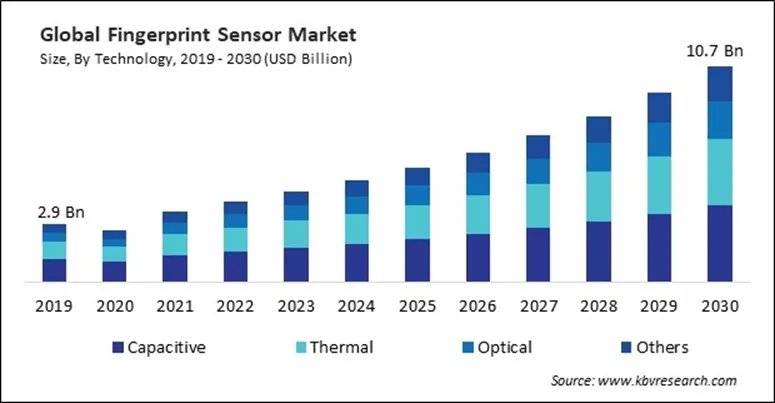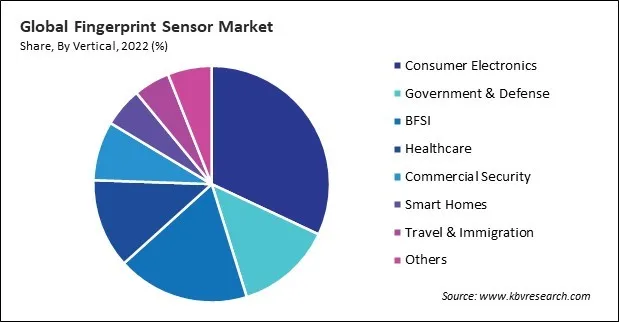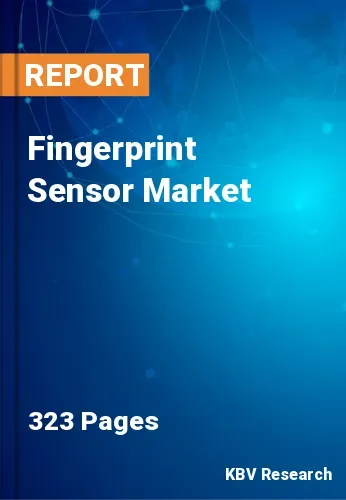“Global Fingerprint Sensor Market to reach a market value of USD 10.7 Billion by 2030 growing at a CAGR of 13.2%”
The Global Fingerprint Sensor Market size is expected to reach $10.7 billion by 2030, rising at a market growth of 13.2% CAGR during the forecast period. In the year 2022, the market attained a volume of 1,21,697.5 thousand units, experiencing a growth of 13.2% (2019-2022).
Fingerprint sensors are integrated into smart door locks, providing secure and convenient home access control. Therefore, the Smart Homes segment captured $216 million revenue in the market in 2022. Homeowners can use their fingerprints to unlock doors, eliminating the need for traditional keys. It contributes to the security of home alarm systems. Homeowners can use their fingerprints to arm and disarm security systems, enhancing overall home security. It can be integrated into smart lockers and safes, providing secure storage solutions for valuable items and documents within a smart home. It contributes to child safety by allowing parents to secure certain areas or devices within the home, ensuring that children cannot access potentially hazardous items.

Fingerprint sensors enhance the security of online transactions, including e-commerce payments and secure account access. It contributes to fraud prevention by offering a biometric authentication layer for online transactions. This helps in reducing the risk of unauthorized access and fraudulent activities. It enables secure and convenient mobile payments. Users can authorize transactions with a simple touch, providing a seamless and contactless payment experience. Additionally, fingerprint sensors are integrated into e-commerce platforms to secure user accounts. It is integrated into start-stop systems, enabling drivers to start and stop the engine with a simple fingerprint scan, adding a layer of convenience to the driving experience. In car-sharing and fleet management scenarios, it provides secure and convenient authentication for accessing shared vehicles, ensuring that only authorized users can use the service. It secures access to the vehicle's trunk or cargo area, providing additional security for valuable items stored in the vehicle. In commercial vehicles, fingerprint sensors contribute to secure access control, prevent unauthorized use, and enhance security for valuable cargo. Thus, integration of the automotive industry has been a pivotal factor in driving the growth of the market.
However, integrating fingerprint sensors into devices can increase manufacturing costs. This cost factor may influence the adoption of fingerprint sensor technology, especially in budget or mid-range devices. Standardization is crucial for interoperability and cost reduction, and challenges in this area can impede market growth. High costs may limit the integration of fingerprint sensors to specific market segments or premium products, reducing the technology's penetration into a wider range of applications. Manufacturers may face challenges in realizing a positive return on investment within a reasonable timeframe if the implementation costs are high. Extended payback periods can impact investment decisions. Thus, high-cost implementation of fingerprint sensors can slow down the growth of the market.


Based on vertical, the market is classified into consumer electronics, government & defense, BFSI, healthcare, commercial security, smart homes, travel & immigration, and others. The BFSI segment acquired a substantial revenue share in the market in 2022. It provides a secure and convenient method for customers to authenticate themselves when accessing online banking services. This adds an extra layer of security to financial transactions and account management. Fingerprint sensors are integrated into ATMs to enhance security. Customers can use fingerprint authentication for secure and convenient cash withdrawals, balance inquiries, and other transactions. It plays a crucial role in securing mobile banking applications. Customers can use their fingerprints to access their accounts, make transactions, and manage financial activities securely.

By technology, the market is categorized into capacitive, thermal, optical, and others. Capacitive fingerprint sensors are widely used in smartphones for secure and convenient device unlocking. Users can simply place their registered finger on the sensor to unlock their devices quickly. Capacitive fingerprint sensors integrated into laptops and personal computers provide a password-free authentication method. Users can log in to their devices and access applications with the touch of their registered finger. Capacitive fingerprint sensors are widely used in access control systems for secure entry to buildings, offices, and restricted areas. They provide reliable and convenient authentication, enhancing overall security.
Free Valuable Insights: Global Fingerprint Sensor Market size to reach USD 10.7 Billion by 2030
Region-wise, the market is analysed across North America, Europe, Asia Pacific, and LAMEA. In 2022, the North America region acquired a significant revenue share in the market. The BFSI sector in North America has embraced fingerprint sensors for secure access to online banking, mobile payments, and ATM transactions, contributing to enhanced security measures. The healthcare industry in North America has adopted fingerprint sensors to enhance the security of electronic health records (EHRs), ensure accurate patient identification, and control access to sensitive healthcare data. Educational institutions in North America utilize fingerprint sensors for secure access control, enhancing campus security by ensuring that only authorized individuals can enter specific areas.
| Report Attribute | Details |
|---|---|
| Market size value in 2022 | USD 4 Billion |
| Market size forecast in 2030 | USD 10.7 Billion |
| Base Year | 2022 |
| Historical Period | 2019 to 2021 |
| Forecast Period | 2023 to 2030 |
| Revenue Growth Rate | CAGR of 13.2% from 2023 to 2030 |
| Quantitative Data | Volume in Thousand Units, Revenue in USD Billion, and CAGR from 2019 to 2030 |
| Number of Pages | 323 |
| Number of Tables | 630 |
| Report coverage | Market Trends, Revenue Estimation and Forecast, Segmentation Analysis, Regional and Country Breakdown, Porter’s 5 Forces Analysis, Company Profiling, Companies Strategic Developments, SWOT Analysis, Winning Imperatives |
| Segments covered | Technology, Vertical, Region |
| Country scope |
|
| Companies Included | Japan Display, Inc., Apple Inc., Synaptics Incorporated, Gemalto NV (Thales Group S.A), Precise Biometrics AB, NEC Corporation, Fingerprint Cards AB, IDEMIA SAS (Advent International, Inc.), NEXT Biometrics Group ASA, Anviz Global Inc. |
By Technology (Volume, Thousand Units, USD billion, 2019-2030)
By Vertical (Volume, Thousand Units, USD billion, 2019-2030)
By Geography (Volume, Thousand Units, USD billion, 2019-2030)
The Market size is projected to reach USD $10.7 billion by 2030.
Expansion of consumer awareness and acceptance are driving the Market in coming years, however, Significant regulatory compliance issues restraints the growth of the Market.
Japan Display, Inc., Apple Inc., Synaptics Incorporated, Gemalto NV (Thales Group S.A), Precise Biometrics AB, NEC Corporation, Fingerprint Cards AB, IDEMIA SAS (Advent International, Inc.), NEXT Biometrics Group ASA, Anviz Global Inc.
In the year 2022, the market attained a volume of 1,21,697.5 thousand units, experiencing a growth of 13.2% (2019-2022).
The Consumer Electronics segment is leading the Market, by Vertical in 2022; thereby, achieving a market value of $3.1 billion by 2030.
The Asia Pacific region dominated the Market, by region in 2022, and would continue to be a dominant market till 2030; thereby, achieving a market value of $4.2 billion by 2030.
Our team of dedicated experts can provide you with attractive expansion opportunities for your business.

 Drivers
Drivers
 Restraints
Restraints
